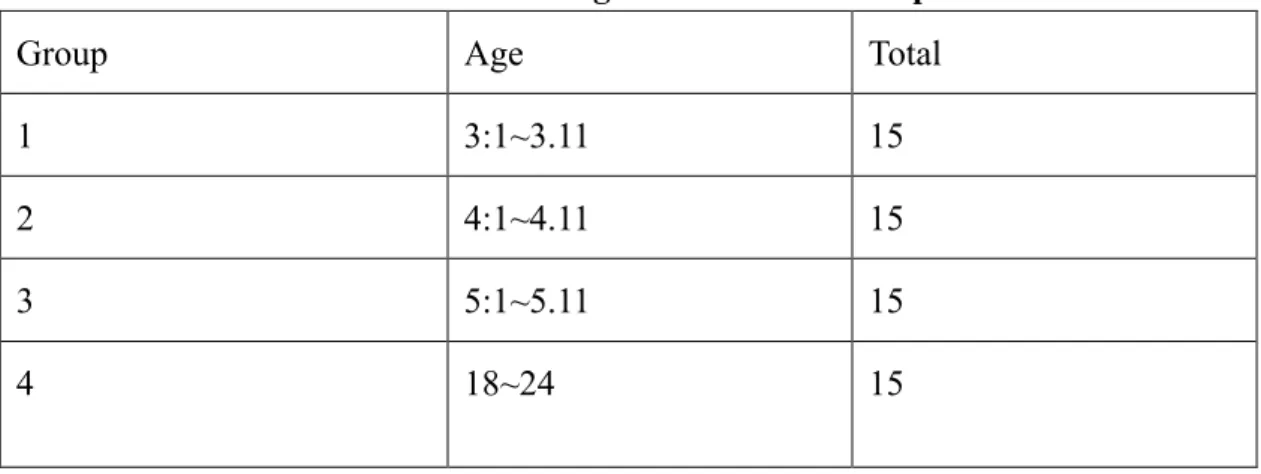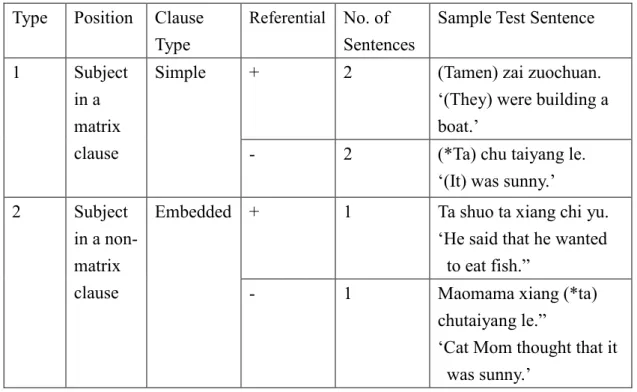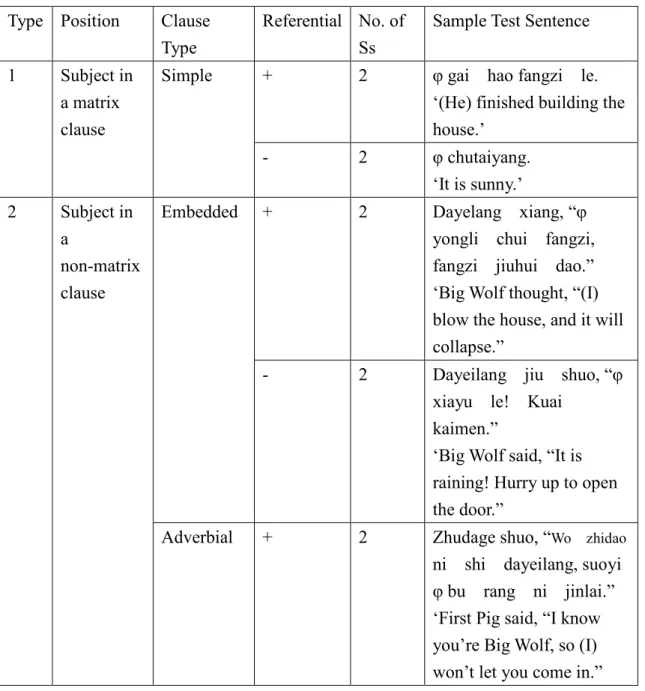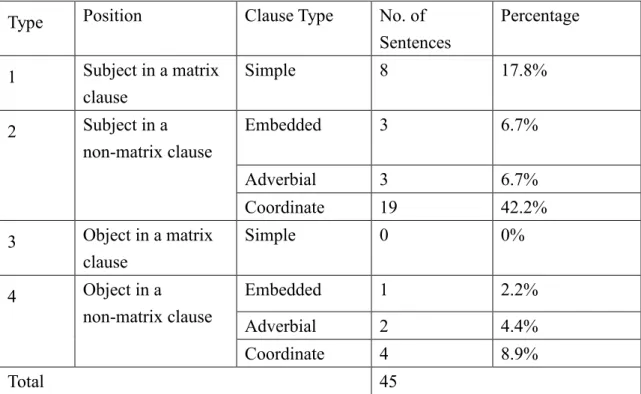Chapter Three Research Design
This chapter shows some related information about the subjects and research design of the present study. Section 3.1 presents the background of the participants for the pilot study. In Section 3.2, the materials and the research methods are described.
Section 3.3 reports the research procedures for the present study. The results of the pilot study as well as the formal study are reported in an attempt to answer the research questions stated in Chapter One. A summary of Chapter Three is given in Section 3.4.
3.1 Participants
Participants of this study were forty-five kindergarten students from a kindergarten in Taiwan, and fifteen adults. The kindergarten kids were all native speakers of some variety of Mandarin Chinese aging from three to six, as shown in Table 3-1. It is noted that children at this age stage are often seen as kindergarten children who have not acquired their native language well. In addition, fifteen Chinese-speaking adults, aged from eighteen to twenty-four, participated in the experiment. The present study conducted a quantitative experimental method to investigate Chinese-speaking kindergarten children’s L1 competence and performance.
The kindergarten children in the experimental groups of the present study were selected from Xinmin Kindergarten in Taipei City. It was a monolingual school for the students to learn Mandarin Chinese as their first language. The control group of this study included adults that was born in Taiwan and spoke Chinese as their mother tongue. They were college students and they all came from a church near Wanfang
Community in Taipei City.
Table 3-1: Background of the Participants
Group Age Total
1 3:1~3.11 15
2 4:1~4.11 15
3 5:1~5.11 15
4 18~24 15
The schooling in the kindergarten is generally described as follows. The kindergarten children have to attend the kindergarten five days a week from eight a.m.
to four p.m. In the kindergarten there are around eighty kindergarten children from three to six years old. Both indoor and outdoor activities are designed for the kindergarten children. For instance, indoor activities include drawing pictures, watching cartoons, telling or listening to stories, and singing nursery rhymes, etc. For outdoor activities, the children play or exercise on the playground, and so forth.
3.2 Materials and Methods
According to French and Nelson (1985), there are three types of experimental design to elicit data from kindergarten children: (1) talk between mother and child or between experimenter and child in the context of “free play” either at home or in a specially designed laboratory that is silent; (2) teacher-child or children talk at preschools, oriented around play, instruction or school-keeping activities; (3) experimental tasks designed to test “comprehension” of certain terms or to elicit
“productions” about the use of particular target terms. The first type is longitudinal that needs a researcher to investigate a single subject for a long period of time. A
production. However, it is not easy for the present experimenter to access such subjects. With respect to the second type, there might be a problem to transcribe and code the data when more than one participant talk simultaneously, which is likely to happen in a classroom. Owing to the restrictions in the first two types, the third type was adopted in this study. Note that this type of study can be considered as a cross-sectional study, i.e., a study in which a group (or groups) of individuals are composed into one large sample, compared on one or more variables, and studied at a single period of time
In Section 2.3, we have seen that most of the previous experimental studies (Wang et al. 1992, Hyams and Wexler 1993, Kim 2000) conducted only production tasks to test their hypotheses. It is well-known that a child’s competence needs not to be equal to his performance. The present study employed both production and comprehension tasks to see if there is any difference between the results of the competence and performance of the subjects. Two experimental tasks were designed in this study, i.e., a Sentence Selection task (i.e., comprehension-based) and a Story-Retelling Task (i.e., a production task). The test materials were designed on the basis of the classification of Chinese null NPs analyzed in Chapter Two.
3.2.1 The Sentence Selection Task
Let us discuss the comprehension task designed in this study first.
Comprehension tasks can be divided into five types: (1) IPL (Intermodal Preferential Looking Paradigm), (2) a picture selection task, (3) an act-out task, (4) truth-value judgment, and (5) grammaticality judgment task (Miller 1981). Among them, the use of grammaticality judgment tasks in linguistic theory is applicable because it provides a means to: (a) assess the speaker’s reactions to sentence types that occur rarely in spontaneous speech, (b) obtain negative evidence on word strings that are not part of
the language, (c) distinguish production problems (e.g., slips, unfinished utterances, etc.) from grammatical production, and (d) isolate the structural properties of the language that are of interest by minimizing the influence of the communicative and representational functions of the language (Schütze 1996). In this study, a sentence selection task, i.e., some kind of a grammaticality judgment task (see Appendix 1) , was used to test how the subjects comprehend each use of null NPs (i.e., null subjects or null objects) in various types of clauses. The subjects were asked to look at the pictures one by one and choose the acceptable sentence(s) according to each picture.
As can be seen in Table 3-2, there are fifteen questions in the Sentence Selection Task (SS Task). The sentences for selection can be classified into nine types based on the syntactic position where they belong to (See Appendix 1 for the detailed information of the task):
Table 3-2: The Classification of Null NPs and Target Sentences in the SS Task Type Position Clause
Type
Referential No. of Sentences
Sample Test Sentence
+ 2 (Tamen) zai zuochuan.
‘(They) were building a boat.’
1 Subject
in a matrix clause
Simple
- 2 (*Ta) chu taiyang le.
‘(It) was sunny.’
+ 1 Ta shuo ta xiang chi yu.
‘He said that he wanted to eat fish.”
2 Subject
in a non- matrix clause
Embedded
- 1 Maomama xiang (*ta)
chutaiyang le.”
‘Cat Mom thought that it was sunny.’
+ 1 Tamen zhua-bu-dao yu, suoyi (tamen) hen nanguo. ‘They could not get fish, so they were sad.’
Adverbial
- 1 Yinwei (*ta) xiayu le,
maomama he maodidi juede leng. ‘Because it was rainy, Cat Mom and Cat Brother felt cold.’
3 Object
in a matrix clause
simple + 4 Tamen qu zhua (yu) le.
‘They went fishing.’
Embedded + Tamen xiang, daole
xinde defang, women jiu keyi zhuadao henduo (yu).
‘They thought that they could get much fish when arriving at a new place.”
4 Object
in a non- matrix clause
Adverbial + 2 Haili you henduo yu,
suoyi tamen xiang qu zhua (yu).
‘There is much fish in the sea, so they want to go fishing.’
5 Fillers + 4 Shuitong li you yu ma?
‘Is there fish in the bucket?’
Total 20
3.2.2 The Story-Retelling Task
As for the Story-Retelling Task (SR Task) (see Appendix 2), it was a production task that can explore how the subjects use null NPs to refer to their antecedents. The
children’s narratives were elicited with one picture sequences of the story of The Three Little pigs.
The experimenter told the participants a sample story according to the pictures before each story-retelling by the participants. The types of null NPs and the corresponding sample sentences are shown in Table 3-3.
Table 3-3: The Classification of Null NPs and the Target Sentences in the SR Task
Type Position Clause Type
Referential No. of Ss
Sample Test Sentence
+ 2 φ gai hao fangzi le.
‘(He) finished building the house.’
1 Subject in a matrix clause
Simple
- 2 φ chutaiyang.
‘It is sunny.’
+ 2 Dayelang xiang, “φ
yongli chui fangzi, fangzi jiuhui dao.”
‘Big Wolf thought, “(I) blow the house, and it will collapse.”
Embedded
- 2 Dayeilang jiu shuo, “φ
xiayu le! Kuai kaimen.”
‘Big Wolf said, “It is raining! Hurry up to open the door.”
2 Subject in a
non-matrix clause
Adverbial + 2 Zhudage shuo, “Wo zhidao
ni shi dayeilang, suoyi φ bu rang ni jinlai.”
‘First Pig said, “I know you’re Big Wolf, so (I) won’t let you come in.”
- 2 zhumama dui sanzhi xiaozhu shuo, “nimen zhangda le, suoyi φ yao ziji chuqu gai fangzi.”
‘Pig Mom said to the three little pigs, “You have grown up, so (you) shall go out to build your own house.”
3 Matrix object
Simple + 4 Zhuerge yong mutou
gai φ.
‘Second Pig built (the house) with wood’
Embedded + 2 Zhuxiaodi shuo, “ Wo
yao yong zhuantou gai.
φ”
‘Third Pig said, “I would like to build (the house) by bricks.”’
4 Non-matrix object
Adverbial + 2 Zhudage zhaodaole
henduo daocao, suoyi ta yong daocao gai φ.
‘First Pig found many straws, so he built (the house) by straws.’
Total 16
3.3 Procedures 3.3.1 Pilot Study
A pilot study was employed to test the subjects’ responses to the eight types of null NPs (see Table 3-3). The procedures and the results of the pilot study are reported in this section.
The participants in the pilot study were twelve Chinese kindergarten children from Xin-miao kindergarten in Taipei City. They were divided into three age groups
(i.e., Mean Age 3.5, 4.5, and 5.5 years old respectively), and each group consisted of four children. As shown in Table 3-4, Chinese null NPs are classified into eight types according to their properties of clausal types and referentiality. The Story Telling Task was employed. The subjects were asked to look at one picture sequences (see Appendix 2) and then tell a story according to the pictures provided. When the subject uttered a sentence with a null NP, we would assume that the NP was dropped since its reference could be identified or recovered by the subject (Chomsky 1982), and then one point was given for the item. However, when the subject did not produce a sentence with a null NP, no point was given.
The major results of the pilot study are shown in Table 3-4.
Table 3-4: The Classification of Null NPs in the Story Telling Task of the Pilot Study
Type Position Clause Type No. of
Sentences
Percentage
1 Subject in a matrix clause
Simple 8 17.8%
Embedded 3 6.7%
Adverbial 3 6.7%
2 Subject in a
non-matrix clause
Coordinate 19 42.2%
3 Object in a matrix clause
Simple 0 0%
Embedded 1 2.2%
Adverbial 2 4.4%
4 Object in a
non-matrix clause
Coordinate 4 8.9%
Total 45
As shown in Table 3-4, the proposition of null subjects highly dominated the proposition of null objects. This is basically corresponding to the concept of the null
null objects in other clausal types.
With regard to age, the proposition of null subjects and null objects decreased with the growth of age as in Table 3-5. In other words, our younger kindergarten children tended to drop a subject or an object when telling a story.
Table 3-5: The Proportion of Null NPs Used by the Three Age Groups
Group Age Null subjects Null objects
1 3:1~3.11 18 4
2 4:1~4.11 10 1
3 5:1~5.11 5 0
There are some shortcomings in the experimental design of the pilot study. For instance, non-referenntial null NPs were seldom found in the data of the kindergarten children. We could not see the difference between the uses of null referenntial and null non-referenntial null NPs. In order to collect more data, a different task (i.e., a sentence selection task) was used in the formal study. The sentences in the sample story told by the experimenter to the kindergarten children were designed to include the various types of null NPs in Table 3-2. More importantly, a comprehension task, i.e, the Sentence Selection Task was adopted to examine children’s comprehension of the various types of null NPs.
3.3.2 Formal Study
Let us turn to the procedures of the two tasks for the formal study to test the comprehension and production of the subjects. We may assume that some kindergarten children may be able to comprehend the null NPs, but they may not use the null NPs properly when asked to orally produce sentences. The SR Task was rather different from the SS Task in the way that it required our subjects to produce
longer utterances established in a discourse. It was used to see which null NPs would appear to be more or less frequent in their story-retelling process.
The narratives produced by the participants were recorded in a formal setting, i.e., a classroom in November, 2008. Each child was called to enter the classroom. In the SR Task, an experimenter presented the material, i.e., a sequence of pictures about The Three Little Pigs (See Appendix 2) to the kindergarten children. The experimenter
told a story about it one time, and the kindergarten children were asked to look at the material for 2-4 minutes, and retold the story (See Appendix 3 for the details of the training process). The experimenter’s direction for the production task was as follows.
(1) Experimenter’s direction: (The kindergarten child’s name), women xianzai yao lai jiang gushi luo ! ni xian ting dagege jiang yici, ranhou zai huan ni jiang yici. Zheyang haobuhao ya? Women xian lianxi yixia.
‘(The kindergarten child’s name), let us tell a story by turns. Listen to me to tell a story about the pictures one time, and then it is your turn to retell the story later, OK? We practice telling another story first.’ Next, the trainer would tell a story
about ‘The Red Hat and Big Wolf’ first11, and the subject would be asked to retell it again. If the subject has no difficulty retelling it, the following words
for further directions would be addressed to him or her.
(2) Hao! Na women kaishi kan sanzhi xiaozhu de gushi. Zheli you shier zhang keaide tupian. Women xian lai kan zhujiao you shei hao bu hao?
‘Good! Now we will start to read the story about Three Little Pigs. Here are twelve lovely pictures. Let us see who the main characters are, OK?’
Next, the following picture was shown to the subject for the introduction of the main characters:
The summary of the story Three Little Pigs was as follows: Pig Mom and three little pigs lived together. Three little pigs grew up gradually. One day, Mama Pig told the three little pigs to go out to build their own house. First Pig found many straws, and he used the straws to build the house. Second Pig built the house with wood.
Third Pig tried very hard to build the house by bricks, and finally he finished building it. One day, the Big Wolf came. He asked First Pig to open his door, but First Pig would not let him in. Big Wolf blew down the house, and First Pig ran to Second Pig's house. However, Big Wolf pushed the wood house softly, and it collapsed. The two pigs finally ran into Third Pig's house, and they were afraid. The Big Wolf ran above the chimney of the house, and he wanted to enter the house by crawling down from there. However, three little pigs had already boiled hot water in a pot. When Big Wolf jumped down from the chimney, he was burnt to death. Three little pigs henceforth lived on a happy life.
Subsequently, the participants were asked to look at each of the twelve pictures and listened to the description of the picture shown by the computer. After listening to the whole story12, they were asked to retell the story according to the pictures.
12 The experimenter has recorded a story sample which contents are shown in Appendix 2. The story sample was then turned into an MP3 file and was played by the computer for the participants to listen.
In the SS Task, twelve pictures were presented to the subjects one by one to ask them to decide the grammaticality of the sentences under each question according to a specific picture. The experimenter’s direction was as follows.
(3) Trainer’s words: (The kindergarten child’s name), women lai kan yige maomi de gushi, xian lai kan zhujiao you shei hao bu hao?
‘(The kindergarten child’s name), let us read a story about cats. Let us have a look at the main characters first.’
And the following pictures were presented to them for introducing the main characters:
Maomama Maodidi Maoyeye
Next, the experimenter told the participants the following instructions:
(4) Dengyixia jiang gushi de shihou, xiaohou he xiaotu (erzhi wanou) dou hu i jiang, women kan shei shuo de bijiao hao, jiu ba tiezhi tie zai ta shenshang, hao bu hao? Hao! Na women kaishi kan gushi luo!
‘Later Monkey and Rabbit will say something about the pictures. Let us see who says better, and you can give it a sticker, OK? ’
The analyses shown in Chapter Four mainly focus on the narratives and the answers to the comprehension check questions produced by the children, and the narratives would be transcribed for the purpose of the present study, and each use of null NPs was categorized according to the classification in Tables 3-2 and 3-3. After transcription, we calculated the frequency counts of each type of null NPs. The example in (5) illustrated the coding procedures for the various types of null NPs. The coreference of the NPs in each clause can be indicated by the co-indexation markers i, j, or k, and the NPs with the same co-indexation marker are anaphoric.
(5) C: S 7 .…zhuxiaodii jiu zhao dao henduo henduo de zhuan kuai – S 8 ... φi gai .. gai shuiniwu \
S 9 .…ranhou zaoshang le, dayelang lai le /
S10 ... dayelangj jjiu shuo: xiaozhu xiaozhu qing kaimen - ..woj yao kankan nii piaoliang de wuzi \
S11 ...zhuxiaodii jiu shuo: φi bu rang ni jjinlai - .. yinwei ni shi dayelang \
E: S7 ‘Third Pig found a lot of brick’
S8 ‘(He) built a house made of cement’
S9 ‘Next, in the morning, the Big Wolf comes’
S10 ‘The Big Wolf said, “Little Pig, please open the door”’
‘I would like to see your beautiful house.’
S11 ‘Third Pig replied, ’ (I) won’t let you in,’
‘since you are the Big Wolf’
As can be seen in (5), the subjects in S8 and S11 are both represented by the zero symbol “φ”, which refers to a zero anaphor or a pro in Chinese. The two implicit subjects have some explicit antecedent, i.e., zhuxiaodi ‘Third Pig’ in the previous
discourse. However, based on the classification in Table 3-2, the subject in IU8 is categorized as a subject in a matrix clause whereas the subject in IU11 is recognized as an embedded subject.
3.3.3 Scoring for the Formal Study
In this section, we briefly explain how our subjects’ performances were scored in the SS Task and how we counted the null expressions based on their syntactic and semantic types in the SR Task.
In the SS Task, if the subject chose the sentence including a null expression, then he/she was given one point. If the subject did not have any response or chose the other sentence, no point was given. For instance, in (6) if the subject chose Rabbit, who used a null expression, one point was given.
(6)
a. The context: Maomama he maodidi zai zuo sheme? Ni zhidao ma?
‘Do you know what Cat Mom and Cat Little Brother are doing?’
b. Sentences for selection:
(1) (xiaohou shuo) Tamen zai zuo chuan.
‘(Monkey says) They are building a boat.’
(2) (xiaotu shuo)zai zuo chuan.‘(Rabbit says) (They) are building a boat.’
c. Questions for the subject: Xiaopengyou ni juede shei shuo de bijiao hao ne? Xiaohou haishi Xiaotu? ‘Who do you think says better, Monkey or Rabbit?’
Since there were fifteen questions, the scores for this task ranged from zero to fifteen.
In the SR Task, the frequency counts of all the null NPs, which were coded according to their types, were counted and presented in percentages. As we mentioned earlier, we would like to know which types of null NPs are frequently or rarely produced in a longer narrative. In addition, if any null NPs occurred in the constructions except the sentence patterns listed in Table 3-3, they would also be analyzed. The data of each task were then be entered into SPSS (Statistical Package for Social Science) and processed by the computer.
3.4 Summary of Chapter Three
This Chapter firstly shows the background of the participants in Section 3.1.
Section 3.2 shows the two experimental tasks adopted in the present study in an attempt to see if methodological effects play a role in the acquisition of null Chinese NPs, and some properties and constructions are chosen to see if any of them play a role affecting the participants’ use of null Chinese NPs. The procedures for conducting a pilot study and the instructions and scoring for the formal study are presented in Section 3.3.




